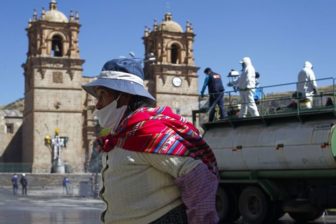Argentina this week formally exited the ninth sovereign debt default in its history. The agreement with creditors took longer than expected, but was settled at reasonable levels, close to original projections, and just in time to avert another blow to the country’s suffering economy. Having reached a deal in the current, uncertain context and with no financial program in hand could be regarded as a success for the government.
The deal reduced Argentina’s debt payments by approximately 27% and — even more crucially — gave the country a three-year window to begin addressing the structural hurdles that have led to long-term stagnation and fiscal imbalances. Without action on those, no debt relief or fiscal adjustment will ever be enough. If by 2023 Argentina’s economy is still deteriorating (as it did in the 10 years prior to the pandemic) and the fiscal deficit remains chronic, steep refinancing costs may quickly push the country back into yet another restructuring, and perhaps default number 10.
This helps explain why sustainability was a buzzword throughout the debt negotiations, and continues to hover above the country now. The onus is now on Argentina to make a concerted, multi-year effort to resolve the country´s longstanding handicaps, which the government has so far failed to provide.
I have written elsewhere about what I believe to be Argentina’s two major macroeconomic hurdles: insufficient exports and a currency nobody wants to save in. It suffices to reiterate that, without new exports and a (inflation-indexed) peso capital market to buffer exchange rate volatility, the country simply cannot grow at the pace required to avoid a new financial nervous breakdown down the road. The current import substitution nostalgia and exchange rate controls are not helping to alleviate these hurdles, postponing the much-needed decline in financial costs. Add to the mix that the monetary financing of the pandemic deficit is fueling inflation expectations and that the government painted itself into a corner with an early – an economically ruinous – quarantine, and it is easy to see why a casual observer may find the debt-deal festivities somewhat premature.
But not all of Argentina’s problems are macro-financial in nature. Indeed, at the root of its financial predicaments, there is a deepening “dual society” that explains not only its persistent poverty and inequality but also, most notably, the volatile and stagnant output that prevents the country from eluding its decades-long middle-income trap.
The 20/80 society
Out of each 100 working-age people in Argentina, at the end of 2019 roughly 35 were inactive, meaning they weren’t looking for a job. Another six counted as unemployed, 15 labored in the informal sector, 14 were registered as self-employed (mostly subsidized and low-income workers), and 10 were public-sector workers. Only 20 of them were stable workers in private-sector jobs, contributing to a generous social spending and social security system that covers their own benefits as well as those of the remaining 80%.
This 20/80 mix might have been 25/75 a few years back. The pandemic, which tested pre-crisis fragilities and accelerated ongoing trends – including Argentina’s deepening insider-outsider dualism – will likely bring it closer to 15/85, raising social spending for the very poor in the process. We do not need an economist to tell us that this is not sustainable. Without genuine inclusion – meaning, more productive, contributing workers – there is simply no way the fiscal numbers could ever square up.
Standard macro remedies, such as the inflationary dilution of public wages and social spending or higher taxes, are but a band-aid on a seismic gap. They are also bound to be temporary – if not counterproductive. Right now, the Argentine government is toying with wealth taxes that are in turn already pushing real investors and entrepreneurs to neighboring tax-friendly countries like Uruguay or Paraguay, taking a good number of high-skilled jobs abroad.
The 20/80 society has its own self-reinforcing characteristics. The imbalance works as a debt overhang: fiscal deficits that are seen as future taxes inhibit investment in the modern sector, feeding into slower growth, a propensity for further crisis and, in turn, fewer jobs. It also creates a new constituency of subsidy-dependent voters that makes active labor market policies politically less appealing. This distorted anti-meritocratic consensus, which relinquishes aspirations of social advance in favor of the redistribution of poverty as a new definition of equity, is reflected into (and is a reflection of) a new “pobrismo” that is more likely to lead to inclusive poverty than to inclusive growth.
From social protection to social mobility
There are no progressive social policies without active labor policies. This may sound trivial, so let me give the idea a more specific content.
In Argentina, as well as in some other Latin American economies, the pandemic triggered a debate over a universal basic income, or UBI. In the Argentine case, a new Emergency Family Income (IFE) was introduced in April to buffer the impact of the lockdown and mitigate the collapse in incomes and consumption during the lockdowns. This was received by roughly 9 million unemployed or precarious workers in May, and the government has expressed its intention to wind it down to something in the order of 3 to 4 million beneficiaries on a permanent basis.
Going forward, a low-budget “basic income” could realistically aim at a modest income floor to eliminate extreme poverty and hunger: a transfer equivalent to the extreme poverty line for those over 18 that do not receive other income. Two aspects are crucial for such a program to succeed: the consolidation of duplicate programs to generate savings (without which the income floor would be fiscally inviable); and the eligibility criteria, which should be qualitative (using a quantitative income threshold would benefit those with informal income) and transparent (to eliminate the middlemen, as was the done in conditional cash transfers for children in Latin America such as Mexico´s Progresa, Brazil’s Bolsa Família or the Argentina’s Asignación por Hijo).
But an income floor, while essential for indigent households, is far from a solution: At best, it consolidates the current structural poverty, public-sector dependence, and socioeconomic dualism; at worst, it may push the 20/80 balance further downhill. For social assistance to become social mobility, an income floor should be complemented by, if not conditioned to, training and job placement programs carefully calibrated to the universe of beneficiaries.
The focus on labor inclusion as a channel for both social mobility and macroeconomic development is, naturally, more general and should include – and adapt to – all three broadly defined labor types: salaried workers, self-employed and the informal and displaced workers linked to the social economy.
Indeed, a professional training agency that projects skill demands in consultation with private employers and experts, certifies institutions, programs and workers’ skills, and keeps track of the worker training record is probably the most critical development strategy readily at hand – in Argentina and, possibly, the region.
On top of that, it is rather inexpensive! And a more efficient allocation of the current budget for vocational training and labor services could go a long way to reduce the ongoing labor precariousness and improve dismal youth unemployment figures. And there is simply no better vehicle for the private sector to demonstrate its social commitment than a contribution – financial and, more importantly, in kind, in the form of training positions, trainers and human resources experts.
There will be no end to the succession of lost decades in Argentina – let alone a middle-class inclusive society – if we cannot put more people to work.
—
Levy Yeyati, an economist, is the dean of the School of Government of Universidad Torcuato Di Tella, and a nonresident senior fellow at The Brookings Institution.









